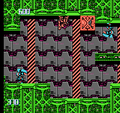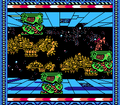- Metal Storm (video game)
-
Metal Storm 
Front cover of Metal Storm (North American version)Developer(s) Irem Publisher(s) Platform(s) Family Computer Release date(s) Genre(s) Action / Platform Mode(s) Single-player Media/distribution Cartridge Metal Storm (重力装甲メタルストーム Jūryoku Sōkō Metaru Sutōmu, "Gravity Armor Metal Storm") is a side-scrolling platforming video game for the Nintendo Family Computer, developed by Irem. It was released in North America in February 1991 and later in Japan in April 1992.
Although the NES does not directly support parallax scrolling, programmers continuously redrew the tiles making up the game's backgrounds in order to animate them scrolling at a different rate than the foreground, giving an illusion of depth, notably in the game's third and fifth stages where there is a "second" background layer that appears to scroll behind the first.
Contents
Known regional differences
- The Japanese version features an opening cutscene before the title screen with credits in English and storyline in Japanese. The entire sequence is not present in the American release. This cutscene can only be unlocked in the American version with a Game Genie code, with some garbled graphics at some points.[citation needed]
- Stage 6 of the Japanese version is significantly harder as the top and bottom of the screen are electrified. This prevents the player from wrapping around from top to bottom (or vice versa) without taking damage. In the American version, the barriers are not present, allowing the player to pass through the top or bottom of the screen without damage.
- The Japanese version features extra narration in Japanese during the very last battle at the end of stage 7 that isn't present in the American version.
- The Japanese and American versions have differently-colored palettes for some of the game's graphics. The Japanese version is brighter due to whiter backgrounds than the American version.
- The Japanese version shows the phrase "warning" before a boss fight whereas the American version shows the phrase "red alert".
- The Japanese version refers to the player's lives as "player" whereas the American version refers to them as "M-308 gunner", the name of the protagonist.
- The text at the end of the game in the Japanese version is in English, despite the game's opening cutscene's text being in Japanese.
Related releases
- During Metal Storm's stage 6 boss fight, the battleship from stage 3 of the first R-Type (a game also developed by Irem) can be seen several times in the background.
Reception
Despite generally being well received by critics and reviewers, Metal Storm has remained a somewhat obscure release, as it was published by a lesser-known 3rd party company without much publicity and released late in the life of the Family Computer. However, issue #22 (March 1991) of Nintendo Power not only had Metal Storm on its cover, but also featured a 12 page article on the game including a lengthy strategy guide. The issue's "Power Meter" review scores of Metal Storm were 3.8 out of 5 for graphics and sound, 3.7 out of 5 for play control, 3.7 out of 5 for challenge and lasting interest, and 3.7 out of 5 for theme and fun. The game's most notable feature is the ability to switch gravitational pull between the top and bottom of the screen at any time, requiring some strategizing from the player to pass through certain areas. The game uses a password system for continuing games at a later time.
Gallery
External links
Categories:- 1991 video games
- Irem games
- Nintendo Entertainment System games
- Nintendo Entertainment System-only games
- Platform games
- Run and gun games
Wikimedia Foundation. 2010.


